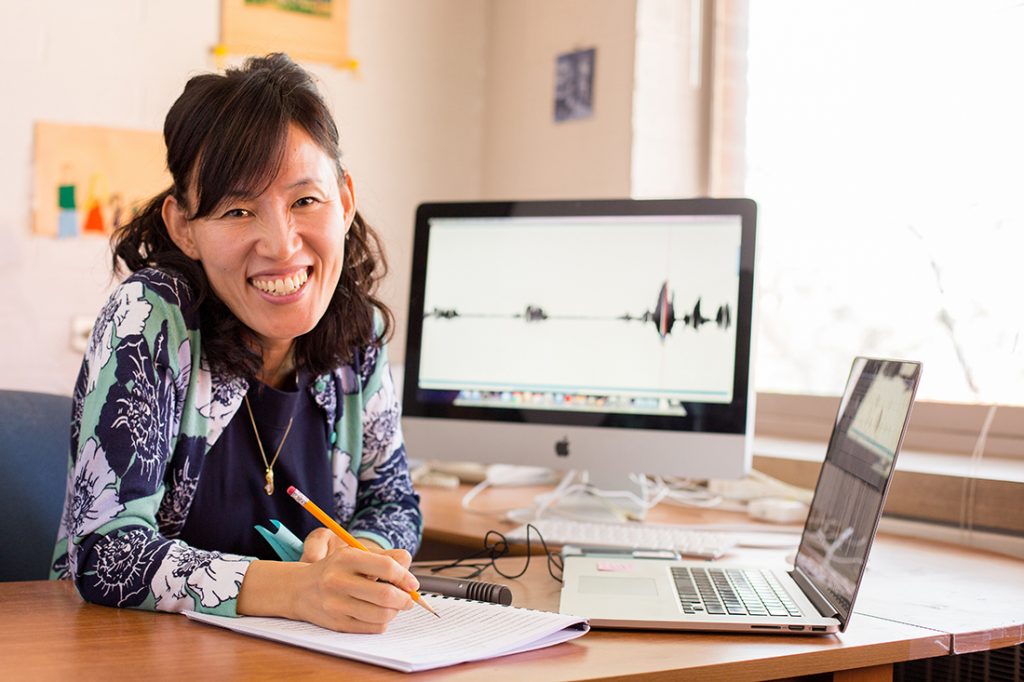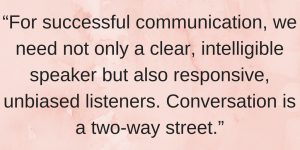Can a person look hard to understand?
The answer, Northern Arizona University researcher Okim Kang found, is yes. And that expectation of listeners—that the person standing in front of them will be less intelligible because English is likely their second language, before the speaker opens their mouth—is harmful both to speakers and to listeners and the ability of all us to effectively communicate.
With that in mind, Kang, an associate professor of applied linguistics, has spent her career figuring out why listeners are biased against people they perceive will be harder to understand and what interventions both speakers and listeners can take to improve understanding and communication. Her research started with a study that brought her to international prominence in the field of linguistics—demonstrating that students reported more trouble understanding a speaker they thought was Asian than they did a speaker they thought was Caucasian, when the same man was speaking both times and the students were looking at different pictures.
This phenomenon, known as reverse linguistic stereotyping, indicates attributions of a speaker’s group membership trigger distorted evaluation of the speaker’s speech pattern even before he or she said a word.
This research was recently highlighted on the “Talk American” episode of Code Switch, an NPR podcast about race in the United States. (Code switching refers to when a speaker talks one way to one group and in a different way to other groups, such as when multilingual speakers speak Spanish at home and English at work.) It is, however, just one piece of the larger communication question to which Kang has applied her research.
“For successful communication, we need not only a clear, intelligible speaker but also responsive, unbiased listeners,” Kang said. “Conversation is a two-way street.”
The groundbreaking study and what came after
The study that jumpstarted Kang’s research asked a simple question: Did a listener’s perception of the speaker’s ability to speak English affect listening comprehension? The study, which she conducted with professor Don Rubin, involved 150 undergraduates, who they had listen to two segments of an astronomy lecture. Another professor—a former radio broadcaster who had the standard American accent, which to most American ears is no accent at all—recorded the two segments, which were of equal difficulty.
As the first segment played, a portrait of a male Caucasian professor wearing a button-down shirt and glasses was projected on screen. As the second segment played a portrait of a male Asian professor wearing the same button-down shirt and glasses was on the screen. In between, a recording of a heavily accented man accompanied by a photo of a non-Caucasian professor served as a distraction tool. After each segment, students took a listening comprehension test.
What Kang found was students, when presented with an Asian face, reported having a harder time understanding the lecture and a decrease in listening comprehension—despite the fact that the same voice did the two readings.
“Because they believed that they were listening to someone else with a second language accent, their listening comprehension was influenced,” Kang said. “They went significantly lower than those from the Caucasian face.”
The next question was why. In succeeding studies, she examined the backgrounds of her test subjects. Students who had negative experiences with international teaching assistants for whom English was a second language were more likely to report difficulty understanding. Another finding showed non-native speakers were much harsher listeners than native speakers of English.
The reverse linguistic stereotyping likely is present in countries throughout the world, Kang said. People tend to not like outsiders who come into their countries and speak differently.
“Non-native speakers of English are often subjected to evaluations of their spoken English that have profound consequences for their education, employment and even citizenship,” Kang and Rubin wrote in their paper, published in the Journal of Language and Social Psychology in 2009. “However, native speakers’ judgments of non-native speakers’ speech are notoriously biased. Native speaker listeners often hear what they expect to hear rather than accurately perceive non-native speakers’ speech. And what they expect to hear is often quite unsatisfactory.”
 Helping speakers
Helping speakers
In April, Kang received her first patent, for a computer program that evaluates speech to determine accents. The program can assess what contributes to someone’s accent and how “far” removed it is from the standard American accent. It is targeted toward non-native English speakers but can be applicable to different dialect detection.
Kang developed this program, the first of its kind to recognize intonation (which means, unlike Siri, that ending a question with a verbal “question mark” is unnecessary), with postdoctoral scholar David Johnson. She is now collaborating with two speech scientists at Radboud University in the Netherlands and one computer engineering professor at the University of Texas-Dallas. The program, which was developed through the NAU Technology Research Innovation Fund and continued through the CIE Global Initiative Program, is important because it allows non-native English speakers to pinpoint where they are having the most difficulty and how to adjust the sounds they make or where to accent a syllable to speak more intelligibly.
Kang’s history with English and accents began with herself. She was her first student, slowly pinpointing the differences in her English and that of a standard American English speaker, correcting sounds and identifying features related to clarity of speech. This process became her master’s thesis. Now, helping others to develop their intelligibility is a big part of her research.
She does it not because accented English is bad or lesser than the perfect radio broadcasting voice. Rather, as an applied linguist, better communication is her goal. If a speaker is difficult to listen to, that speaker’s words are likely to be discounted; they are a less effective communicator.
Helping listeners
But it’s not all on the speaker. Listeners play a big part in successful communication. Using a number of grants from various sources, her recent studies have focused more on intervention. In one study, she had undergraduate students take the listener comprehension assessment, then spend an hour with international teaching assistants (TAs). They drank coffee, ate pizza, discussed cultural differences and did a couple of puzzles together. Those who participated in the inter-group contact showed positive changes in their attitude toward international TAs, leading them to evaluate the TAs’ speech as more comprehensible and instructionally more competent.
In a subsequent study, Kang connected a class of Anthropology 101 students with students from the Program for Intensive English at NAU. The two groups of students interacted three times, talking, doing puzzles and competing to build a marshmallow tower. Both studies showed a significant difference between the speech evaluation and perception surveys done at the beginning and end of the semester.
Kang also has a research partnership with the University of Virginia, which has a large population of international TAs. In one study, undergraduate students volunteered to spend an hour a week with these TAs, participating in structured contact activities. The study found these students were more likely to listen to and comprehend accented speech.
“Without even learning about the speakers’ speech features, even just having fun together will change perceptions and make people willing to listen to someone else’s speech,” Kang said. “That itself makes a big difference.”
She recently finished a project funded by Educational Testing Service about intelligibility of different varieties of English. In this three-year project, she explored various ways of measuring intelligibility, the intelligibility threshold of diverse accent varieties and the effect of international accents and shared first language on listening comprehension tests.
As her career progresses, she is stepping outside the experimental more often, going into the real world and observing communication between different groups. She worked with a local high school teacher to determine how students reacted to teachers with accents. She also did a study with her students about local restaurant managers’ reaction to potential employees with accents.
Kang has submitted grant proposals to study what happens in the brain when we hear accented speech and is working on a National Science Foundation proposal to further her work on the computer program. The UVA research project is ongoing, and she and her doctoral students continue to study interventions that will help listeners be more receptive to different accents.
It’s a question about which Kang cannot stress the importance enough.
“I’ve spent my entire research life on this accent issue and communication success,” she said. “I’ve seen so many immigrants treated badly, who have all different kinds of accents. I hope my research can help them in any way possible. Spreading awareness of language-related bias is more important in the U.S. right now than ever before.”
Heidi Toth | NAU Communications
(928) 523-8737 | heidi.toth@nau.edu





